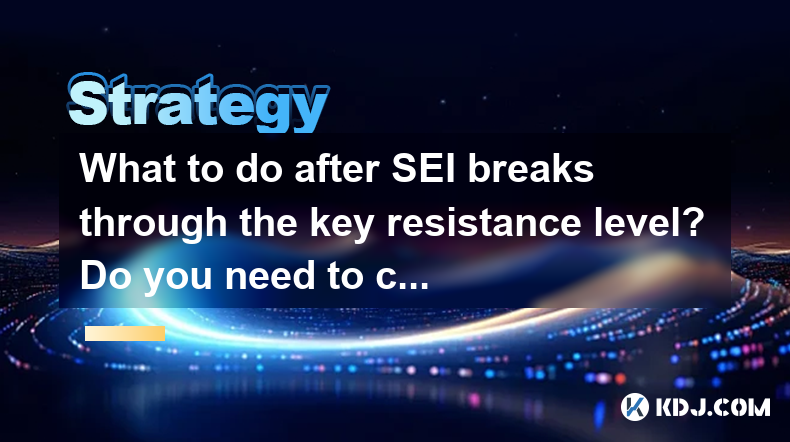-
 bitcoin
bitcoin $108842.957301 USD
-1.88% -
 ethereum
ethereum $3931.777121 USD
-1.66% -
 tether
tether $1.000186 USD
-0.03% -
 bnb
bnb $1153.250882 USD
-2.20% -
 xrp
xrp $2.367904 USD
-1.94% -
 solana
solana $186.182050 USD
-4.20% -
 usd-coin
usd-coin $0.999997 USD
0.00% -
 tron
tron $0.316949 USD
-1.00% -
 dogecoin
dogecoin $0.190780 USD
-3.12% -
 cardano
cardano $0.651324 USD
-2.67% -
 hyperliquid
hyperliquid $37.141055 USD
-0.85% -
 ethena-usde
ethena-usde $0.999224 USD
-0.09% -
 chainlink
chainlink $17.579031 USD
-2.47% -
 bitcoin-cash
bitcoin-cash $509.426284 USD
-2.79% -
 stellar
stellar $0.315298 USD
-2.93%
What to do after SEI breaks through the key resistance level? Do you need to chase the rise?
After SEI breaks through a key resistance level, traders must decide whether to chase the rise or opt for strategies like waiting for a pullback or using limit orders.
May 03, 2025 at 08:43 pm

After SEI breaks through a key resistance level, cryptocurrency traders often face the dilemma of whether to chase the rise or adopt a different strategy. This article will explore the various actions you can take post-breakthrough, the risks associated with chasing the rise, and alternative strategies to consider. Understanding these options can help you make more informed decisions in the volatile crypto market.
Understanding Key Resistance Levels
Key resistance levels are price points at which an asset tends to face selling pressure, preventing it from rising further. When SEI breaks through such a level, it indicates a potential shift in market sentiment, suggesting that buyers are gaining control over sellers. This breakthrough can be a signal for traders to reassess their positions and consider their next moves.
To identify a key resistance level, traders often use technical analysis tools such as trend lines, moving averages, and historical price data. A breakthrough is confirmed when the price closes above the resistance level, often accompanied by increased trading volume.
Chasing the Rise: Risks and Considerations
Chasing the rise refers to buying an asset after it has already experienced a significant price increase. While this strategy can lead to quick profits if the upward trend continues, it comes with substantial risks. The main concern is that the price may have already peaked, and entering at a high point increases the likelihood of buying at the top.
When considering whether to chase the rise after SEI breaks through a key resistance level, it's essential to assess the following factors:
- Market Sentiment: Analyze social media, news, and market indicators to gauge whether the bullish sentiment is likely to continue.
- Volume: A high volume during the breakthrough suggests strong buying interest, but a subsequent drop in volume could indicate waning momentum.
- Technical Indicators: Use tools like the Relative Strength Index (RSI) to determine if the asset is overbought, which could signal an impending correction.
Alternative Strategies After a Breakthrough
Instead of chasing the rise, traders can consider several alternative strategies to capitalize on SEI breaking through a key resistance level:
- Wait for a Pullback: After a breakthrough, prices often retrace to the former resistance level, now acting as support. Buying during this pullback can offer a better entry point with a lower risk of buying at the top.
- Set a Limit Order: Place a limit order just above the new support level to automatically enter a position if the price retraces to that level.
- Use a Trailing Stop: If you already hold SEI and it breaks through a key resistance level, consider using a trailing stop to lock in profits while allowing for further upside potential.
Implementing a Wait for Pullback Strategy
If you decide to wait for a pullback after SEI breaks through a key resistance level, follow these steps:
- Identify the New Support Level: The former resistance level often becomes the new support level. Monitor the price action to confirm this new support.
- Set Price Alerts: Use trading platforms to set price alerts at the new support level to notify you of potential buying opportunities.
- Analyze Volume: Ensure that the volume during the pullback remains healthy, indicating genuine buying interest at the new support level.
- Enter the Position: Once the price reaches the new support level and shows signs of stabilization, enter your buy order.
Using Limit Orders Post-Breakthrough
To implement a strategy using limit orders after SEI breaks through a key resistance level, follow these steps:
- Determine the Entry Price: Identify the price just above the new support level where you would like to enter the position.
- Place the Limit Order: On your trading platform, place a limit order at this price. This order will only execute if the price retraces to your specified level.
- Monitor the Order: Keep an eye on the order to ensure it executes as planned. If the price does not retrace to your entry level, consider adjusting the order or exploring other strategies.
Applying Trailing Stops to Existing Positions
If you already own SEI and it breaks through a key resistance level, using a trailing stop can help you manage your position effectively. Follow these steps:
- Set the Trailing Stop: On your trading platform, set a trailing stop at a percentage or fixed amount below the current market price.
- Monitor the Price Movement: As the price of SEI continues to rise, the trailing stop will automatically adjust to lock in profits.
- Adjust the Stop Level: Depending on your risk tolerance, you may need to adjust the trailing stop level to balance between securing profits and allowing for further gains.
Analyzing Market Sentiment and Technical Indicators
To make informed decisions after SEI breaks through a key resistance level, it's crucial to analyze market sentiment and technical indicators:
- Market Sentiment: Use platforms like Twitter, Reddit, and crypto news sites to gauge the overall sentiment towards SEI. Positive news and community support can reinforce the likelihood of continued upward momentum.
- Technical Indicators: Utilize tools such as the Moving Average Convergence Divergence (MACD), Bollinger Bands, and the Relative Strength Index (RSI) to assess the strength and potential direction of the price movement. An RSI above 70 might indicate that SEI is overbought, suggesting a potential pullback.
Frequently Asked Questions
Q: How can I tell if SEI's breakthrough is a false signal?A: A false breakthrough often occurs with low volume and lacks follow-through in subsequent price action. Monitor the volume during the breakout and observe whether the price sustains above the resistance level. If the price quickly falls back below the resistance, it might be a false signal.
Q: What other indicators can I use to confirm a breakout in SEI?A: Besides volume, other useful indicators include the Average True Range (ATR) to measure volatility, the On-Balance Volume (OBV) to confirm the trend with volume, and the Ichimoku Cloud to provide a comprehensive view of support and resistance levels.
Q: Should I use leverage when trading SEI after a breakthrough?A: Leverage can amplify both gains and losses. It's generally advisable to use leverage cautiously, especially after a breakthrough when the market can be more volatile. Ensure you have a solid risk management strategy in place if you decide to use leverage.
Q: How long should I hold SEI after it breaks through a key resistance level?A: The holding period depends on your trading strategy and risk tolerance. Short-term traders might look to capitalize on immediate price movements, while long-term investors might hold for more extended periods to benefit from potential further gains. Always set clear exit strategies based on your analysis and goals.
Disclaimer:info@kdj.com
The information provided is not trading advice. kdj.com does not assume any responsibility for any investments made based on the information provided in this article. Cryptocurrencies are highly volatile and it is highly recommended that you invest with caution after thorough research!
If you believe that the content used on this website infringes your copyright, please contact us immediately (info@kdj.com) and we will delete it promptly.
- Solana, Dogecoin, and the Crypto Dip: Bargain Hunting or Dodging Bullets?
- 2025-10-17 10:45:16
- Gold, Bitcoin, and Investment: Navigating the Digital Frontier in Style
- 2025-10-17 10:25:15
- Bengals vs. Steelers: Live Updates, Week 7 - Who Dey or Black & Gold?
- 2025-10-17 10:25:15
- Dogecoin, Thumzup, and DOGE Rewards: Will Real-World Utility Spark a Rebound?
- 2025-10-17 10:45:16
- BullZilla, Cryptos, Buy October: Navigating the Crypto Jungle in Style
- 2025-10-17 10:50:01
- Cardano, TRON, and MAGACOIN: Navigating the Crypto Landscape in 2025
- 2025-10-17 08:45:15
Related knowledge

Practical parameter settings for a Bitcoin multi-timeframe moving average system
Sep 18,2025 at 10:54pm
Optimizing Timeframe Combinations for Bitcoin Trading1. Selecting appropriate timeframes is crucial when building a multi-timeframe moving average sys...

How can I filter out false breakouts in Dogecoin high-frequency trading?
Sep 22,2025 at 01:00am
Understanding False Breakouts in Dogecoin Trading1. A false breakout occurs when Dogecoin's price appears to move beyond a defined support or resistan...

Techniques for identifying tops and bottoms in the Bitcoin on-chain NVT model
Sep 20,2025 at 07:54pm
Understanding the NVT Model in Bitcoin Analysis1. The Network Value to Transactions (NVT) ratio is often described as the 'P/E ratio' of the cryptocur...

What does the surge in open interest in Bitcoincoin futures mean?
Sep 20,2025 at 11:18pm
Understanding the Surge in Dogecoin Futures Open Interest1. A surge in open interest within Dogecoin futures indicates a growing number of active cont...

How can I use the Ethereum USDT premium to gauge market sentiment?
Sep 18,2025 at 11:55pm
Understanding the Ethereum USDT Premium1. The Ethereum USDT premium refers to the price difference between USDT (Tether) traded on Ethereum-based plat...

What should I do if Ethereum staking yields decline?
Sep 20,2025 at 06:18am
Understanding the Causes Behind Declining Ethereum Staking Yields1. The Ethereum network transitioned to a proof-of-stake consensus mechanism with the...

Practical parameter settings for a Bitcoin multi-timeframe moving average system
Sep 18,2025 at 10:54pm
Optimizing Timeframe Combinations for Bitcoin Trading1. Selecting appropriate timeframes is crucial when building a multi-timeframe moving average sys...

How can I filter out false breakouts in Dogecoin high-frequency trading?
Sep 22,2025 at 01:00am
Understanding False Breakouts in Dogecoin Trading1. A false breakout occurs when Dogecoin's price appears to move beyond a defined support or resistan...

Techniques for identifying tops and bottoms in the Bitcoin on-chain NVT model
Sep 20,2025 at 07:54pm
Understanding the NVT Model in Bitcoin Analysis1. The Network Value to Transactions (NVT) ratio is often described as the 'P/E ratio' of the cryptocur...

What does the surge in open interest in Bitcoincoin futures mean?
Sep 20,2025 at 11:18pm
Understanding the Surge in Dogecoin Futures Open Interest1. A surge in open interest within Dogecoin futures indicates a growing number of active cont...

How can I use the Ethereum USDT premium to gauge market sentiment?
Sep 18,2025 at 11:55pm
Understanding the Ethereum USDT Premium1. The Ethereum USDT premium refers to the price difference between USDT (Tether) traded on Ethereum-based plat...

What should I do if Ethereum staking yields decline?
Sep 20,2025 at 06:18am
Understanding the Causes Behind Declining Ethereum Staking Yields1. The Ethereum network transitioned to a proof-of-stake consensus mechanism with the...
See all articles










































































